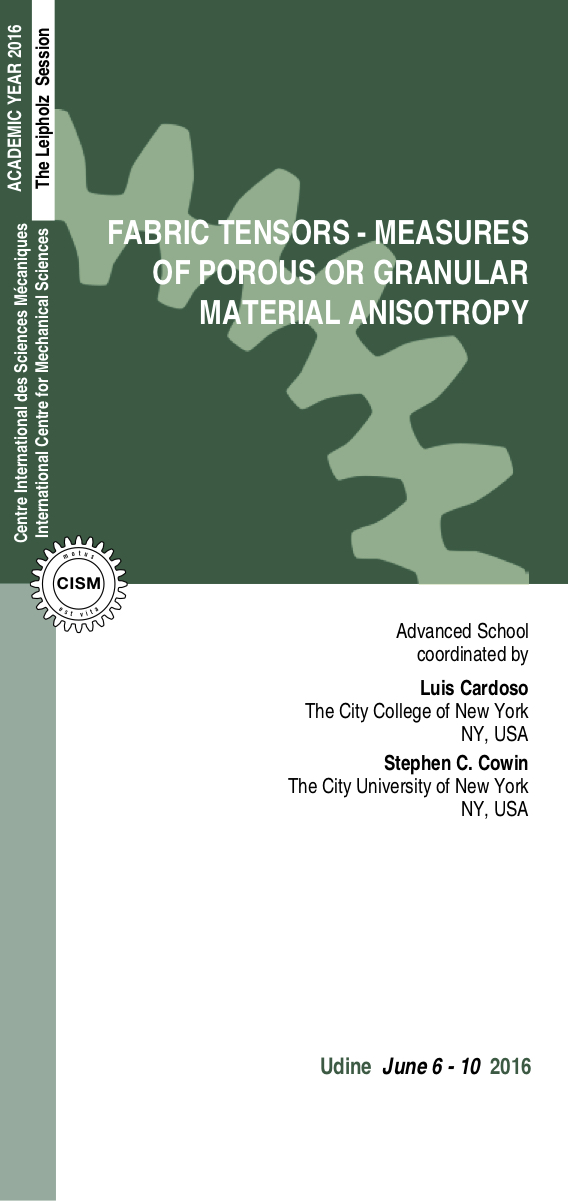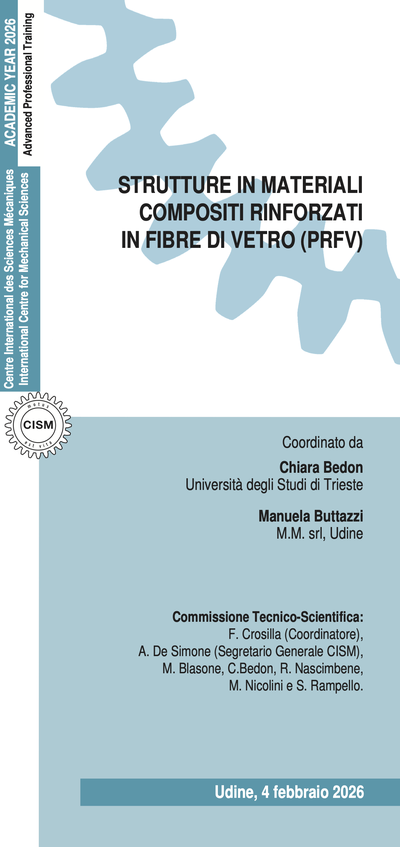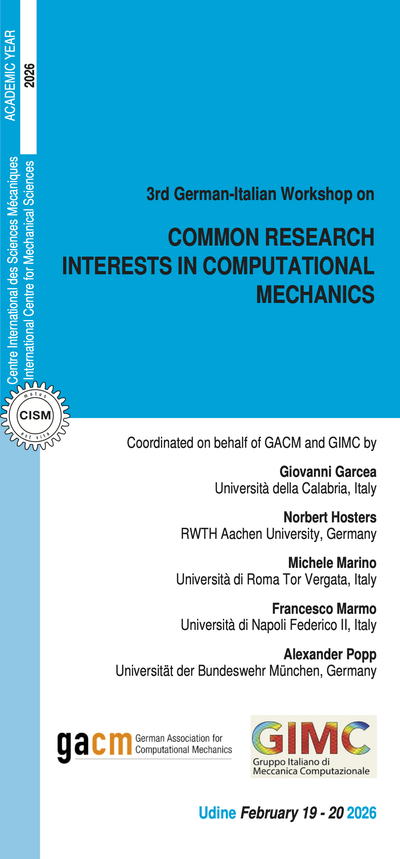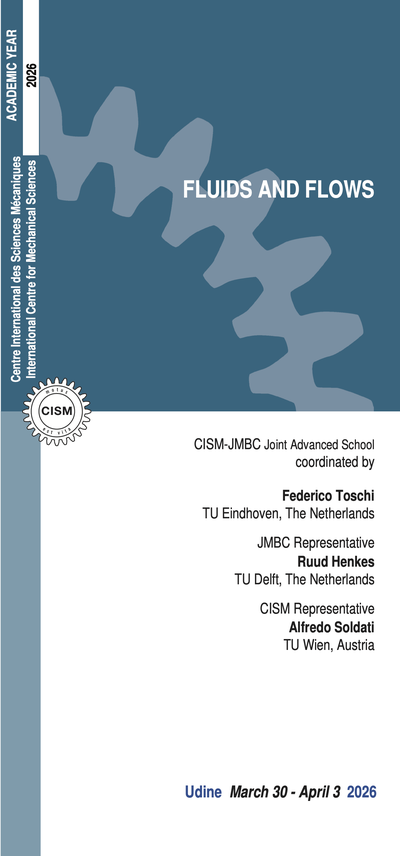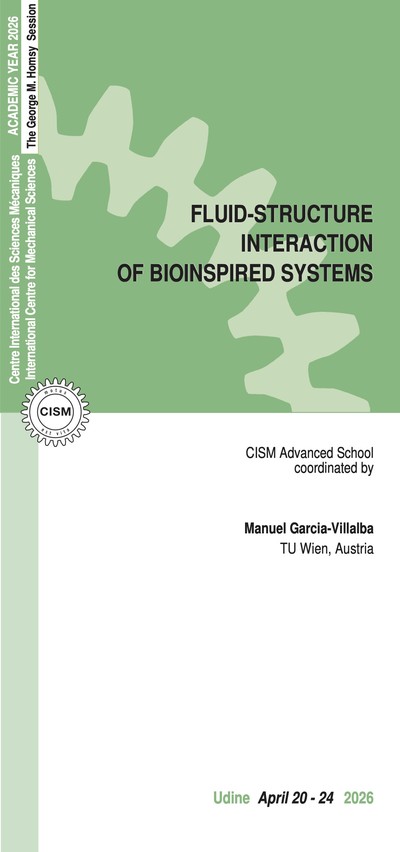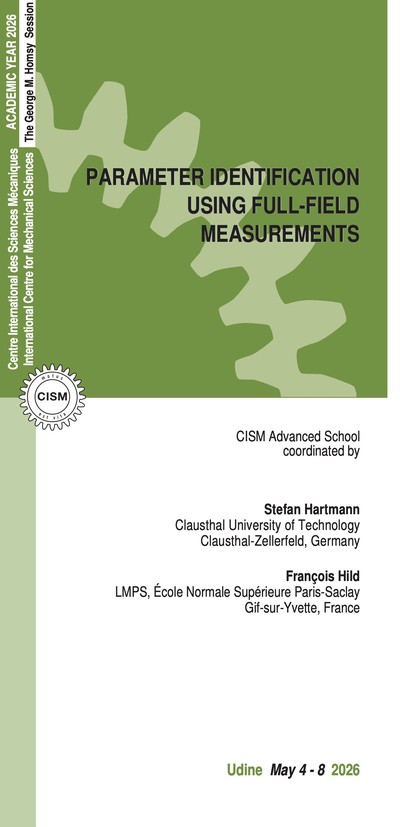Fabric tensors are tensors that characterize the anisotropic architecture of the microstructure in a porous material. Fabric tensors are considered to be higher order measures of porous media microstructure, after porosity or relative volume fraction. The fabric tensor concept arose in geomechanics and soil mechanics and is now widely applied in biomechanics. This workshop will address the imaging of porous media or granular media, the quantification of porous media morphology or granular architecture (quantitative stereological measures) and the structure-function relationship in porous/granular anisotropic media from the theoretical, experimental and numerical viewpoints. Specifically, the role of fabric in the elastic and inelastic behavior of porous media will be discussed. An analysis of failure mechanisms in a porous/granular medium and its constituents will be presented, as well as the role of fabric on the strengths and on the toughness of porous/granular media. The inclusion of the fabric tensor as a measure of the porous medium anisotropy in both quasi-static and dynamic poroelasticity will be presented. The relationship between fabric, porosity, tortuosity and permeability of the porous medium will be considered. Also, the influence of fabric on poroelastic wave propagation will be analyzed. Ultrasonic wave propagation is a noninvasive technology for the measurements of material properties of geomaterials and biomaterials. Fabric dependent poroelasticity will be presented as the basis for understanding elastic ultrasound in porous media. The presentation will include theory, experiment and technology. The determination of drained and undrained elastic properties from fabric measurements (imaging) and monotonic elastic test loadings will be discussed. Inverse models in porous elastic propagation will be reviewed, that is to say models that determine drained and undrained mechanical properties from ultrasound data. Different boundary- and volume- based techniques for estimating orientation distribution functions (ODFs) will be presented. Also, different strategies will be described for analyzing and estimating fabric tensors from ODFs. The relationship between Cartesian tensors and spherical harmonics and their relevance in the analysis of anisotropic materials will be discussed. Higher- order descriptors of anisotropy and estimation of fabric tensors in gray-scale images will also be introduced. The course is addressed to doctoral students, starting and senior researchers, in the fields of modeling the mechanical behavior of materials, particularly in geomechanics and biomechanics.
Cardoso L., Cowin S.C. "Fabric dependence of quasi-waves in anisotropic porous media", J Acoust Soc Am. 2011; 129(5):3302-16. Cowin S.C. "The relationship between the elasticity tensor and the fabric tensor", Mech of Mat. 1985; 4(2):137-47. Cowin S.C. and C.H. Turner. "On the relationship between the orthotropic Young's moduli and fabric", J Biomech. 1992; 25(12):1493-94. Cowin S.C., Cardoso L. "Fabric dependence of wave propagation in anisotropic porous media", Biomech Model Mechanobiol. 2011; 10(1):39-65. Souzanchi M.F., Palacio-Mancheno P.E., Borisov Y.A., Cardoso L. and SC Cowin. "Microarchitecture and bone quality in the human calcaneus: local variations of fabric anisotropy", J Bone Miner Res. 2012; 27(12):2562-72. Zysset P.K. & A. Curnier. "An alternative model for anisotropic elasticity based on fabric tensors", Mech of Mat. 1995; 21(4):243-50. Gross T., Pahr D. and P.K. Zysset. "Morphology-elasticity relationships with decreasing fabric information of human trabecular bone in three major anatomical location", Biomech Model Mechanobiol. 2013; 12(4):793-800. Schwiedrzik J., Wolfram U. and P.K. Zysset. "A generalized anisotropic quadratic yield criterion and its ap- plication to bone tissue at multiple length scales", Biomech Model Mech- anobiol. 2013;12:1155-1168. Moreno R., Borga M., and Ö. Smedby. "Generalizing the mean intercept length tensor for gray-level images", Med Phys 2012; 39(7):4599-4612. Moreno R., Borga M., and Ö. Smedby. "Fabric tensors: a review. Visualization and processing of tensors and higher order descriptors for multi-valued data", Westin, C-F, Vilanova A, Burgeth B (Eds). Springer, 2014; 271-292. Moreno R. and Ö. Smedby. "Volume- based fabric tensor through Lattice- Boltzmann simulations". Proc. ICPR 2014; 3179-3184. Luding S. "Introduction to Discrete Element Methods: Basics of Contact Force Models and how to perform the Micro-Macro Transition to Continuum Theory", European Journal of Environmental and Civil Engineering. 2008; 12:785-826. Magnanimo V. and S. Luding. "A local constitutive model with anisotropy -- ratcheting under 2D biaxial isobaric deformation", Granular Matter. 2011; 13(3):225-232. Imole O.I., Wojtkowski M., Magnanimo V. and S. Luding. "Micro-Macro Correlations and Anisotropy in Granular Assemblies under Uniaxial Loading and Unloading", Phys. Rev. E. 2014; 89(4):042210. Kumar N., Luding S. and V. Mag- nanimo. "Macroscopic model with anisotropy based on micro-macro informations", Acta Mechanica. 2014; 225(8):2319-2343. Bendsoe M.P. and O. Sigmund. "Topology optimization: theory, methods and applications". Berlin: Springer. 2003; 370 pp. Fraldi M. "Problems and Fundamental Models for Inverse Methods in Composite Materials", in The WILEY Encyclopedia of Composites", Second Edition. 2012; 4:2402-2413. Lekhnitskii S.G. "Theory of elasticity of an anisotropic elastic body". S. Francisco: Holden-Day. 1963; 404 pp. Nemat-Nasser S., and M. Hori. "Micromechanics: overall properties of heterogeneous materials". The Netherlands: North-Holland Elsevier Science Publishers. 1993; 810 pp.
Luis Cardoso (None)
1. Role of porosity and microarchitecture in material symmetry of biological tissues
2. Monday Q&A
3. The role of microarchitecture in the mechanical function of biological tissues
4. Experimental methods to measure quasi-static elastic constants and yield behavior
5. Experimental methods to measure dynamic permeability
6. Poroelastic ultrasound tomography.
Stephen C. Cowin (None)
1. The types of material symmetry
2. Introduction of participants & lecturers
3. The relationship between the anisotropic elastic constants and fabric
4. Quasi-static fabric dependent poroelasticity
5. Dynamic fabric dependent poroelasticity
6. Friday Q&A.
Massimiliano Fraldi (None)
1. Fabric tensor derived from Flugge-like porous structures
2. Fabric tensors and homogenization
3. Some insights into RVE-invariant fabric tensors
4. Fabric tensor-based topology optimization approaches
5. Q&A Thursday
6. Fabric-like tensor measures in finite elasticity.
Stefan Luding (None)
1. Particle Simulation (DEM = Discrete Element Method) Introduction
2. Contact Models
3. Measuring Elastic constants from DEM – including fabric and anisotropy
4. Towards Continuum Models for anisotropic materials with change of microstructure
5. From slow (quasi-static) to fast, inertial flows.
Rodrigo Moreno (None)
1. Fabric tensors: a geometric perspective
2. Boundary-based orientation distribution functions (ODF)
3. Volume-based ODFs
4. Q&A Wednesday
5. Estimation of fabric tensors from ODFs
6. Introduction to higher-order and gray-scale fabric tensors.
Philippe Zysset (None)
1. Fabric tensors and their computation in trabecular bone
2. Alternative fabric-elasticity relationships
3. Q&A Tuesday
4. A generalized fabric-based yield criterion
5. Experimental and computational approaches to fabric-mechanical property relationships in trabecular bone
6. A modular framework to include fabric in finite element analysis.
